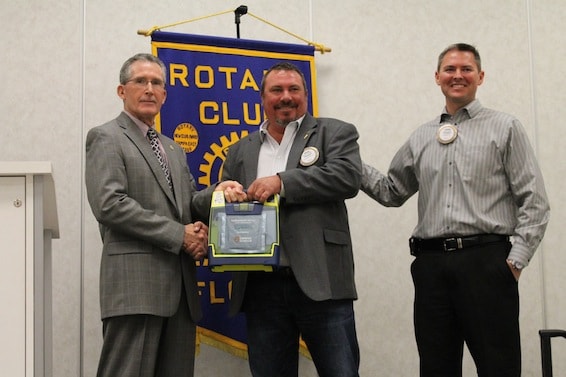
Two years ago, the Plant City Noon Rotary Club set a goal: to make sure all of the cars in the Plant City Police Department’s fleet were equipped with an automated external defibrillator.
They met that goal Monday, Feb. 16, when the club presented the last of the AEDs, 20 to be exact, to the police department.
It might have seemed like a lofty goal to many. In 2013, only four of the police department’s more than 50 cars were equipped with portable AEDs.
These life-saving devices cost several thousand dollars each, which is why so few PCPD cars had them.
That also meant that Rotary would have to raise quite a sum.
“Our club found a need within the community as it often does, and this time it was with our own Plant City Police Department,” Aaron Davis, who was Rotary president when the project began, said.
The Rotary Club announced this project in August 2013, and through its two biggest annual fundraising events, Dancing With the Locals and the Wild Game Cookout, along with individual donations and corporate sponsorships, the club has raised close to $70,000 toward its goal.
The police department received AEDs in installments as the Rotary Club was able to purchase them. Soon after the club had delivered its initial seven units, three of them had already been used, and one of those instances was a life-saving event.
Anytime a 911 call comes in, there could be a life at risk of sudden cardiac arrest. In some cases, lives are lost simply because the responders did not have the necessary equipment to jumpstart a heart.
“One of the most frustrating things for a law enforcement officer is to get on the scene of a medical emergency and not have the equipment he needs to be able to sustain life,” chief of police Ed Duncan said.
AEDs have saved lives in Hillsborough County. Now that every PCPD car has an AED on board, more lives are likely to be saved in Plant City.
“Without this type of support … we would not be able to perform the jobs that we are asked to do every day,” Duncan said. “With this device here, we’ll be able to add that secondary level of first responder care, and hopefully save lives.”
How It Works
An AED, or automated external defibrillator, is a battery-operated, portable device that helps to jumpstart an unconscious person’s heart.
The user attaches sticky pads with sensors to the chest of the person who is having sudden cardiac arrest, and the sensors send data to a computer to analyze whether an electric shock is needed. If a shock is needed, voice prompts from the AED guide the user through the shock process.
The process must be done quickly, because every minute of sudden cardiac arrest leads to a 10% reduction in the likelihood of survival.
Information from nhlbi.nih.gov.
Contact Catherine Sinclair at csinclair@plantcityobserver.com.
